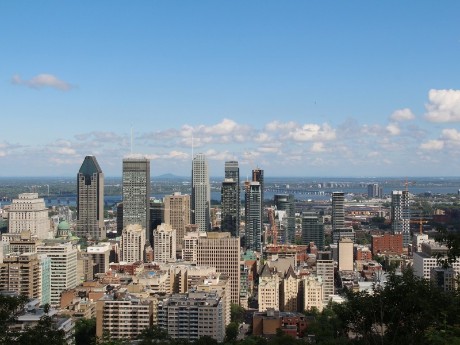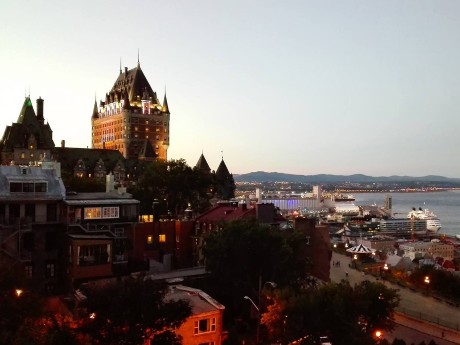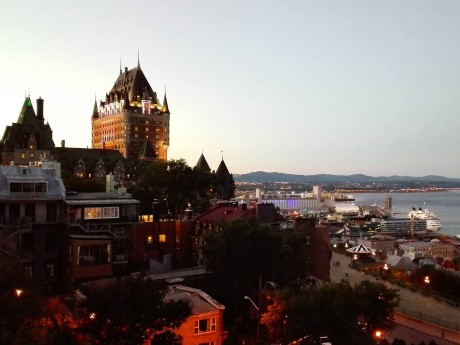Quebec: Montreal and Quebec City
Montmorency Falls, Château Frontenac, Mount Royal Park, whale-watching, and underground cities. Discover the enchanting allure of Quebec's culture, history, and scenery. In Old Montreal (Vieux-Montréal), stroll along cobblestone streets, admire the historic architecture, and explore iconic landmarks like Notre-Dame Basilica and Montreal Museum of Fine Arts. Hike to the summit of Mount Royal Park for panoramic views of the city.
Read more
Montmorency Falls, Château Frontenac, Mount Royal Park, whale-watching, and underground cities. Discover the enchanting allure of Quebec's culture, history, and scenery. In Old Montreal (Vieux-Montréal), stroll along cobblestone streets, admire the historic architecture, and explore iconic landmarks like Notre-Dame Basilica and Montreal Museum of Fine Arts. Hike to the summit of Mount Royal Park for panoramic views of the city. Visit Old Quebec (Vieux-Québec), a UNESCO World Heritage site, where you can explore the impressive Place Royale and Citadelle of Quebec. Venture beyond the city walls to Montmorency Falls, a natural wonder taller than Niagara Falls. Don't forget to explore the Plains of Abraham (Battlefields Park), an expansive urban park with a historical significance, and fully immerse yourself in Quebec's rich culture by visiting the Museum of Civilization, before dropping by restaurants in the city for a traditional Quebecois meal. Waterviews strives to offer accommodation options within walking distance of water and/or in an area of touristic interest. Our prices include taxes (but excludes local tourist taxes). Customize your trip to your personal preferences with optional activities (hit the “Add Activities’’) or change hotels, etc. Contact us for customization at no extra cost at: Service@waterviewstravel.com
Destinations
- Montreal
- Quebec City
Itinerary
Montreal

Montreal may not be the political centre of Quebec, but it certainly is the region’s cultural heart. Boasting itself as one of the most diverse cities of North America, French speaking Montreal dazzles with its architecture, frequent festivals and an excellent music scene. However, nothing is as persuading as the first-class gastronomy, which includes top-notch patisseries and cafés and outstanding restaurants and bars with an endless supply of local and international dishes.
Read more
Montreal may not be the political centre of Quebec, but it certainly is the region’s cultural heart. Boasting itself as one of the most diverse cities of North America, French speaking Montreal dazzles with its architecture, frequent festivals and an excellent music scene. However, nothing is as persuading as the first-class gastronomy, which includes top-notch patisseries and cafés and outstanding restaurants and bars with an endless supply of local and international dishes.
Additional Information
On an island in the St. Lawrence River at the historically highest navigable point, Montreal has been a strategic location since before the arrival of Europeans in Canada. A thriving Iroquoian town called Hochelaga was on the site of present-day Montreal when explorer Jacques Cartier first visited in 1535. In 1642, the tiny town of Ville-Marie was founded as a Catholic mission by Paul Chomedey, sieur de Maisonneuve. It soon became a centre of the fur trade. After its capture by the English in 1762, Montreal remained (until the 1970s) the most important city in Canada and was briefly capital of the province in the 1840s.
Prohibition on sales of alcohol in the United States during the 1920s and 1930s made Montreal a Mecca for cross-border fun seekers from nearby New England and New York. The city built up a seedy, yet playful, industry in alcohol, burlesque, and other vices. In the 1960s, an urban renewal drive centred on Expo 67. The World's Fair in Montreal brought a subway system (the métro) and attractive urban parks and is considered to be one of the most successful World Fairs. Over 50 million visitors gathered in Montreal during this memorable summer. The 1976 Olympics left a strikingly idiosyncratic stadium and many other urban improvements.
The opening of the Saint Lawrence Seaway in 1959, though much-lauded as an economic boom, spelled the beginning of the end for Montreal's economic dominance in Canada. Once the transition point between western railways and eastern sea carriers, Montreal watched helplessly as some of this business moved farther west, up the now navigable seaway, to ports in Ontario and on Lake Superior. The Quebec sovereignty movement, which began to pick up steam in the 1960s, further chilled the atmosphere for Canada-wide businesses, many of which moved their headquarters to Toronto.
Following an economic depression in the 1980s and 1990s, Montreal became more secure in its place in North America and the world. It remains a centre of culture, arts, computer technology, aerospace, the biotech industry, and media for all of Canada.
Orientation
It has been said that Montréal is the only city in the world where the sun "rises in the south".
Montrealers use an unconventional compass, using the river and the mountain as cardinal points. When you are downtown, the St Lawrence River is “south” and Mount Royal is “north”; making the West Island and the East End correct in both their names and orientations. This tends to confuse visitors because the “East” End is really north and the “South” Shore is east, and the St Lawrence River runs almost north-south at this location.
Most local maps use this convention as do the highways around the city. For example, Autoroute 15 north actually runs northwest and Autoroute 40 east runs northeast.
To underscore this fact, a Montreal map will show that the "south end" of Victoria Bridge is in fact further north than the "north end".
Gay Montreal
Montreal is an extremely inviting destination for gay and lesbian tourists. Canada's contributions to gay rights have become widely known, but Quebec was the first province in Canada to pass a non-discrimination law for sexual orientation and to provide same-sex civil unions (although Toronto was the first municipality in Canada to do so). Same-sex marriage is legal in Quebec (neither residency nor citizenship are required for a marriage licence, but there is a three-week waiting period after you receive the licence) as it is in the rest of Canada. Canadian and Quebec immigration law allow residents to sponsor their same-sex partners or spouses.
Montreal is a very safe, open, and inviting city. The métro station in the Gay Village, Beaudry, is marked with rainbow pillars. Divers/Cité Montreal's pride celebration (last week of July, first week of August) is the second-largest in Canada after Toronto's.
Climate
The climate of Montreal is a true humid continental climate with 4 distinct seasons. The city has warm—and occasionally hot & humid—summers, generally mild spring and autumn, and often very cold & snowy winters. Montreal gets over 2,000 hours of sunshine annually. Precipitation is moderate throughout the year, with around 2 metres of snow per season.
Visitor information
© Sourced from Wikivoyage
Quebec City

Settled on cliffs overlooking the St. Lawrence Seaway is Quebec City, a UNESCO World Heritage Site and the capital of Canada’s Quebec Province. Its colonial centre features winding cobblestone streets lined with bistros and boutiques, magnificent architecture dating from the 1600s, and is topped by the spectacular Château Frontenac. Quebec City mixes its history with modernity and hosts a wide range of cultural events including an incredible winter festival.
Read more
Settled on cliffs overlooking the St. Lawrence Seaway is Quebec City, a UNESCO World Heritage Site and the capital of Canada’s Quebec Province. Its colonial centre features winding cobblestone streets lined with bistros and boutiques, magnificent architecture dating from the 1600s, and is topped by the spectacular Château Frontenac. Quebec City mixes its history with modernity and hosts a wide range of cultural events including an incredible winter festival.
Additional Information
Quebec City is referred to as the National Capital in the province. Much of the business here is of the administrative and bureaucratic nature, which would normally make a city quite dull. Fortunately, the city has a remarkable history, as the fortress capital of New France since the 16th century. Although the town's day-to-day life leaves things a little yawny at times, the vibrant historical centre makes for an incredible visit.
Quebec was first settled by Europeans in 1608 in an "Habitation" led by Samuel de Champlain, and celebrated its 400th anniversary in 2008. The generally accepted dates of Champlain's arrival in the city, July 3rd and 4th, were marked with major celebrations. The area was also inhabited by Native peoples for many centuries before the arrival of the Europeans, and their ongoing presence has been notable since then.
When it was founded by the French to make a claim in the New World, the name Quebec referred to just the city. It is an Aboriginal word for "where the river narrows" as the St. Lawrence River dramatically closes in just east of the city. It rests on 65-m-high (200-foot) cliffs with stunning views of the surrounding Laurentian Mountains and the St. Lawrence River. Under French rule from 1608 to 1759, the major industries were the fur and lumber trades. The French lost the city and the whole colony of New France to the British in the Battle of the Plains of Abraham in 1759. Much of the French nobility returned to France, and the British assumed rule over the remaining French population. The rulers of the colony allowed the French to retain their language and religion, leaving much of the culture intact. In the 1840s, there was an influx of Irish immigrants during the Potato Famine. Due to cholera and typhus outbreaks, ships were quarantined at Grosse Isle to the east of the city past l'Île d'Orléans. The bodies of those who perished on the journey and while in quarantine are buried there. The city remained under British rule until 1867 when Canada West (Quebec) and Canada East (Ontario) joined New Brunswick and Nova Scotia to form the Dominion of Canada.
French is the official language of the province of Quebec though in the tourist areas of Quebec City, English is widely spoken as a second language by almost all of the staff. It is also not unusual to find Spanish, German and Japanese spoken in many establishments in Vieux-Quebec. Outside of the tourist areas, some knowledge of French is advisable and perhaps necessary, depending on how rural the area is. While older locals struggle when attempting to sustain a discussion in English, most people under 35 should be able to speak conversational English. Less than a third of the overall population is bilingual French/English.
In French, both the city and the province are referred to as Québec. Context determines the difference. By convention, the province is referred to with masculine articles (le Québec, du Québec, or au Québec), and the city takes no article at all (de Québec, à Québec). Provincial road signs and other official signage refer to Quebec City as simply Québec.
Quebec City was named the 5th best city destination in North America and 10th in the world in 2010 by Condé Nast Traveler, and best Canadian city for culture, 4th best Canadian destination, and 7th most romantic city in the world in 2010 by TripAdvisor.
Climate
Quebec has a humid continental climate, meaning there's considerable temperature variation over the year. Winters are cold with temperatures below -20°C certainly not unheard of (for a comparison to European destinations, the winter temperature range is comparable to Rovaniemi at the Arctic Circle while Quebec is at the same latitude as Central France!), with strong winds amplifying the cold temperature, and often also much snow.
Summer daytime temperatures are often just above +20°C, though it can get considerably hotter. Spring and fall tend to be rather short transition periods, and periods of warm weather far into the fall are common.
Orientation
Orienting yourself in Quebec is fairly easy. Many sights of interest are in the Old Town (Vieux-Québec), which constitutes the walled city on top of the hill. Many surrounding neighbourhoods, either in Haute-Ville ("Upper Town") or in Basse-Ville ("Lower Town"), are of great interest: Saint-Roch, Saint-Jean-Baptiste, Montcalm, Vieux-Port and Limoilou. Haute-Ville and Basse-Ville are connected by many staircases, all of which are unique, such as the aptly-named Escalier Casse-Cou ("Breakneck Stairs") and the more easily climbable "Funiculaire".
The city spreads westward from the St. Lawrence River, for the most part extending from the old city. The true downtown core of Quebec City is just west of the old city. Across the river from Quebec City is the town of Lévis. Frequent ferry service connects the two sides of the river.
Visitor information
© Sourced from Wikivoyage





